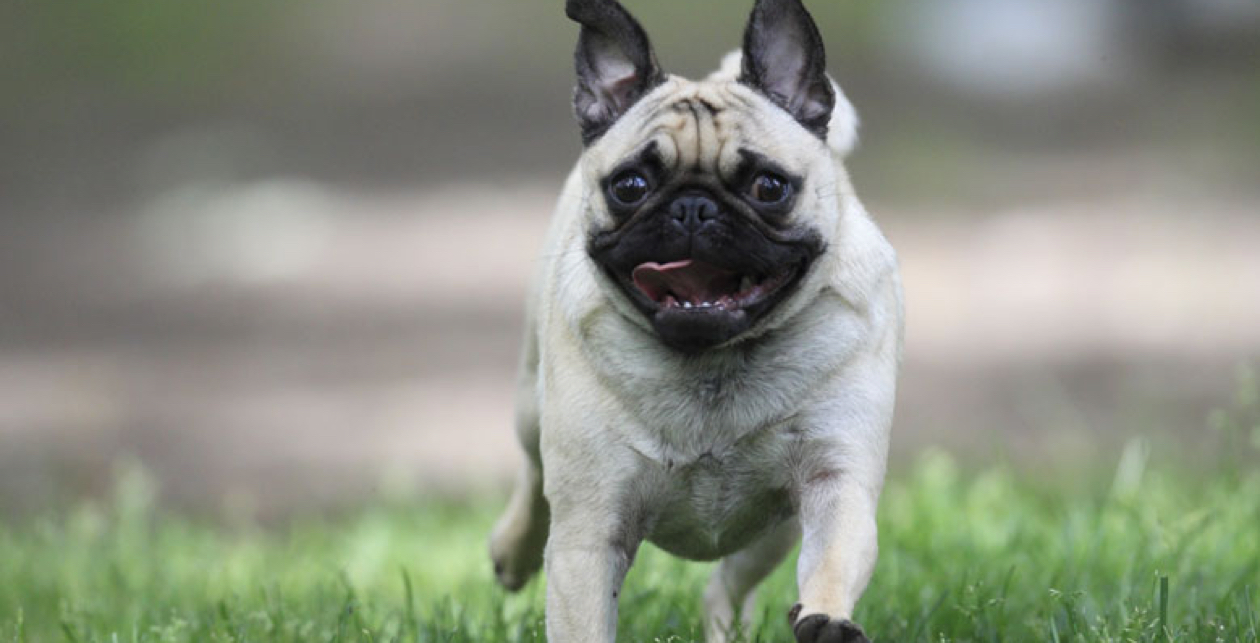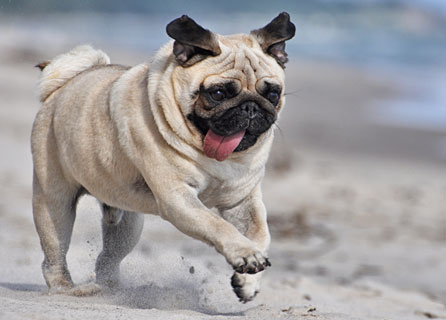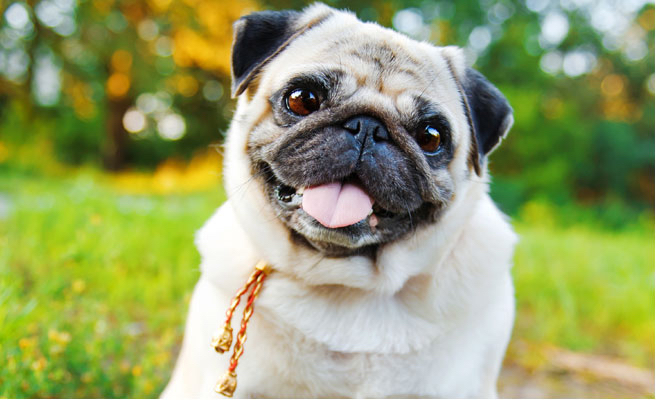
Pug breed guide
Pugs are affectionate, smart and playful, with a huge personality and like nothing more than to be the centre of attention. Find out more about this compact, outgoing dog, from their temperament and how they should be groomed, to their health and exercise needs.
Breed information and advice
The Pug is from the toy dog group and was bred to sit on laps, making them the perfect companion. Their love of people makes them a great breed choice for families with or without children. Here's more you should know:
- The Pug is a sociable, loving and loyal dog, and will follow their owners everywhere.The Pug is a sociable, loving and loyal dog, and will follow their owners everywhere.
- They have a double coat meaning they can shed a lot, so you may want to invest in a good vacuum cleaner.They have a double coat meaning they can shed a lot, so you may want to invest in a good vacuum cleaner.
- They'll typically weigh between 6kg and 8kg, when fully grown.They'll typically weigh between 6kg and 8kg, when fully grown.
- A healthy Pug will usually live for up to 10 years.A healthy Pug will usually live for up to 10 years.
Typical size of a Pug: Small: 25cm-36cm

Recommended exercise and nutrition
Pugs are relatively low-maintenance when it comes to exercise, and while your dog will enjoy playing outdoors, they can be quite subdued when inside.
They'll need up to one hour of exercise a day, whether walking on a lead or playing in a secure garden. Your dog can be sensitive to heat, so make sure you limit their outside time in warmer months. A Pug puppy’s exercise needs to be limited to free-running and gentle play, as excessive walking and jumping can harm their joints while they're growing.
Pugs are known for their love of food, so take care not to overfeed your dog, as this breed can also be prone to obesity. You should give your Pug two high-quality meals each day, to ensure they're getting the right nutrients. The exact amount will vary depending on their age, size and how active they are. Be sure to read the recommended serving portions on the food packet.
Up to one hour of exercise per day
Pugs are loveable dogs who enjoy relaxing and playing outside. Be careful not to over-indulge your companion, and encourage them to exercise.

Common health problems and illnesses
There’s no reason why your Pug shouldn’t live a long and happy life. However, being aware of the ailments your dog will be more prone to, along with the associated symptoms, can help you to deal with any health issues that crop up.
Brachycephalic obstructive airway syndrome (BOAS) is the term used to describe upper airway breathing problems. Due to their compact airways, Pugs might occasionally find it difficult to breathe. They could also find it hard to pant, meaning they can’t cool themselves down as effectively as other dogs after exercise or in warmer weather. For advice on allergies, obesity and other conditions that might have caused breathing problems, contact your vet.
Hemivertebrae in dogs is a congenital condition where your dog has one or more vertebrae that are deformed; the vertebrae may be fused or wedge-shaped leading to twisting in the spine. If you're noticing any pain or weakness in your dog, or if they’re unable to walk, your vet will conduct a physical examination and will likely then have x-rays done.
Skin fold dermatitis is an infection in a pocket between two folds of skin. Skin fold pockets are warm and moist, providing a perfect place for bacteria and yeast to grow. The first sign of skin fold dermatitis tends to be smell and red skin between the folds. Prevent this condition by regularly cleaning and drying in between your dog’s skin folds. Contact your vet if you notice your dog has skin problems.
Pugs have big round eyes, giving them a soft and attentive expression but the shape and size also mean they can be prone to problems such as corneal ulcers. If you notice your dog is keeping an eye closed, or they’re experiencing pain or discharge from the area, take them to your vet who will be able to advise on the treatment available.
A common injury affecting this breed is a dislocated kneecap, also known as a luxating patella. This is a condition that they’ll have been born with, and signs to look out for include occasional skipping or hind-leg lameness. Simple surgery is usually the best way to treat this condition, but your vet can advise on the best course of action.
Find out about insurance for your Pug
Learn how pet insurance works and what kind of cover you might need for your dog.
Grooming advice
Despite their short coats, Pugs moult a lot so it’s important you regularly groom your dog to keep them looking their best. Frequent brushing all over will remove dead or loose hair, and you may want to give them a bath once a month. When washing, make sure to pay special attention to the folds of skin on the face, as these can become sore if not properly dried.
You should also regularly check your Pug’s nose, which can become painful if dirt and debris are not removed properly. Wipe the area using a damp cotton pad or baby wipe, followed by a dry tissue.
Be sure to check their eyes as they can be vulnerable to infection or irritation. Remove debris with a moist cotton pad while being careful that no fluff is left behind. It’s also important to use a different cotton pad for each eye, so any infection that may be present is not passed to the other.
Fun and interesting facts
- A group of Pugs is known as a ‘grumble’.A group of Pugs is known as a ‘grumble’.
- In Germany your dog would be called a Mop.In Germany your dog would be called a Mop.
- This breed is believed to be the oldest in existence.This breed is believed to be the oldest in existence.
- Originally this dog was bred to sit on the laps of Chinese emperors.Originally this dog was bred to sit on the laps of Chinese emperors.
Important information
The content on this page aims to offer an informative introduction to pet breeds, but does not constitute expert veterinary advice. If your dog or cat falls ill or has an injury, contact your vet immediately.
All facts and figures were correct at date of publication and were compiled using a range of sources.
Discover more breeds
Browse our other cat and dog guides to learn about some of the UK’s most popular breeds.